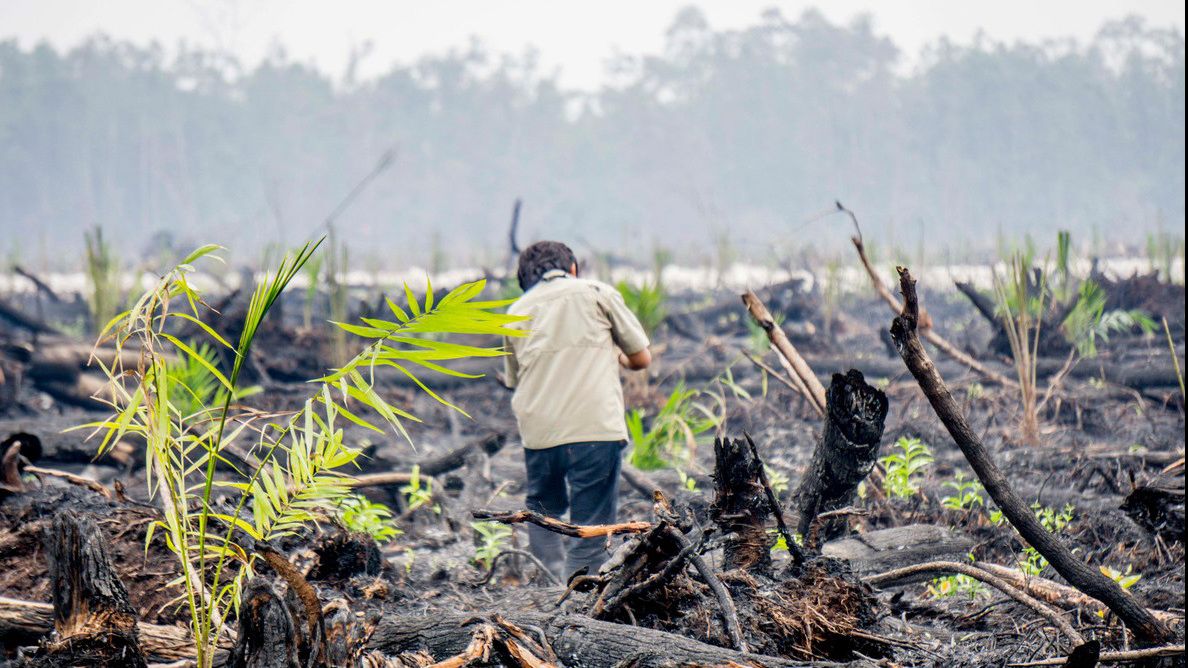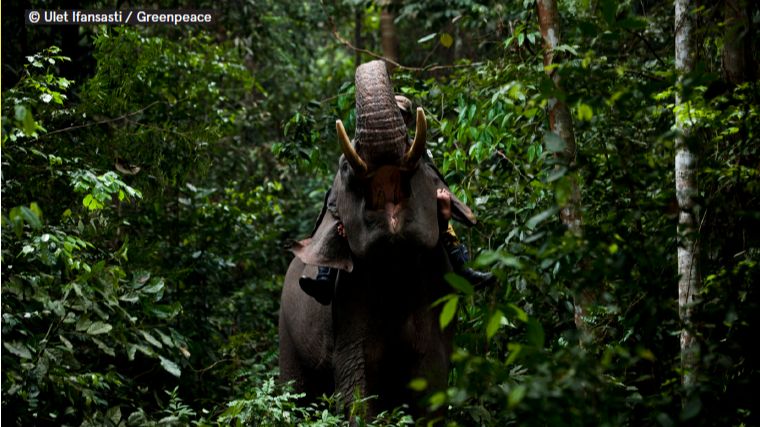(For full story, read ‘Deceased Estate’ report published by Greenpeace Indonesia)
Indonesia’s remaining forests are at the nexus of intersecting crises of dwindling biodiversity, climate change and Indigenous rights violations. Megadiverse and carbon rich, these forests are home to over 2,000 Indigenous communities for whom cultural identity and livelihood are bound up with the land. They have proven to be effective custodians of natural resources, but few enjoy legal recognition for their ownership of customary forests. Instead, the country’s forests are at a growing risk of conversion to plantations, impacting the climate, natural biodiversity heritage and communities who rely on them.
Clearing for oil palm plantations has been the largest single cause of deforestation in Indonesia over the past two decades.[1] Such losses should have been minimised by the establishment of the national forest estate, which is a designation for areas intended to be managed permanently as forest.[2] It includes production forests, which are subject to limited economic activity, such as forest product extraction. It also covers forests for protecting watersheds and conservation forests, which include nature reserves and the country’s national parks.
Oil palm plantations are illegal in the forest estate. Yet the analysis conducted by Greenpeace and TheTreeMap for this report found that by the end of 2019 there was a total of 3.12 million hectares (Mha) of oil palm planted inside Indonesia’s forest estate. Of the total, half (1.55 Mha) are industrial[3] oil palm plantations. We found at least 600 plantation companies with plantings of over 10 ha inside the forest estate.[4] The remaining half of oil palm plantings inside the forest estate (1.56 Mha) are smallholdings.[5]
This means that of Indonesia’s officially estimated[6] total 16.38 Mha oil palm plantings, 19% are found inside the forest estate. Palm oil is being produced from plantings inside every category of forest estate including national parks, wildlife sanctuaries, and even UNESCO sites, across Sumatra, Kalimantan, Sulawesi, and Papua. Our analysis indicates that as of 2019, oil palm plantings in Indonesia’s forest estate occupy 183,687 ha of land previously mapped as orangutan habitat, and 148,839 ha of Sumatran tiger habitat.

Forest crime scene investigation: Burned peat forest remnants, freshly planted with oil palm seedlings, near the Nyaru Menteng Orangutan Sanctuary west of Palangkaraya, Central Kalimantan. 27 Oct, 2015
There has been a catastrophic failure of law enforcement to protect the forest estate. Large oil palm plantation groups have not been prosecuted, while mill owners and palm oil traders have also gone unpunished, despite a law against dealing in commodities produced from illegal plantings within the forest estate. Instead, between 2012 and 2020, three increasingly lenient amnesties have been issued, providing companies with an opportunity for retrospective legalisation for their activity inside the forest estate.
The first two amnesties were tempered with provisos and ministerial discretion. The third amnesty however, introduced along with the 2020 ‘Omnibus’ Job Creation Law, raises the prospect of across-the-board retrospective legalisation for companies that have until now either ignored the law or been ineligible under the previous amnesties. According to our analysis, this last amnesty throws open the door to oil palm plantation companies occupying 665,945 ha of forest estate that were not previously eligible for retrospective legalisation.
A concerning number of companies certified under the Roundtable on Sustainable Palm Oil (RSPO) and Indonesian Sustainable Palm Oil (ISPO) schemes are involved. RSPO member plantation companies have a combined total of some 283,000 ha of oil palm planted in the forest estate. Greenpeace has identified almost 100 RSPO member companies that each have over 100 ha planted in the forest estate, while eight have over 10,000 ha each. Despite ISPO being a more recently established initiative, ISPO-certified companies have a total of 252,000 ha planted in the forest estate.
The above findings are despite both RSPO and ISPO requiring full compliance with all applicable national laws and regulations. ISPO certification specifically requires auditors to check for unlawful plantations in the forest estate. Nevertheless, over a quarter of the 735 companies reported to be ISPO-certified have plantings in the forest estate.
Besides unlawful operations inside the forest estate in general, protected areas are specifically off limits under the ISPO scheme.[7] Nonetheless, we found there are 24 ISPO-certified palm oil concessions impinging on protected forest, including one company with a 4,306 ha overlap, and 17 companies overlapping with conservation areas, including one company with a 1,766 ha overlap.
The significant presence of ISPO-certified plantations in the forest estate jeopardizes the scheme’s goals of curbing greenhouse gas emissions and raising international market acceptance of Indonesian palm oil.
The 2021 “code red for humanity” IPCC report states that after fossil fuel use, land use change including activities such as forest conversion for oil palm plantations, is the second greatest contributor to human-induced climate change. It estimates that 9-19% of total anthropogenic CO2 emissions over the past decade resulted from land use and land use change.[8]

An elephant reveals itself inside Tesso Nilo National Park. This pristine peatland forest environment is threatened by irresponsible expansion of oil palm plantations. 29 September, 2011
In that context, our report calculates conservatively that 104 million metric tons of carbon has been lost from primary forests converted to oil palm within Indonesia’s forest estate between 2001-2019. This doesn’t include losses from soil and peatlands. Land use change such as this is far and away the biggest contributor to Indonesia’s greenhouse gas emissions.[9] The goal of reducing emissions by 29% of the business-as-usual scenario by 2030 will be difficult to achieve if the same lack of law enforcement persists through to 2030 and beyond.
Greenpeace Indonesia urges the Indonesian government to uphold transparency and justice to protect the environment and Indigenous rights. Companies illegally operating oil palm plantations in the forest estate must face law enforcement, not enjoy amnesties. Ecological considerations must be incorporated into spatial planning, while independent smallholders must be assisted, ensuring sustainable livelihoods are achievable alongside improved biodiversity protection. The global community cannot rely on ISPO or RSPO certification to ensure palm oil is being produced and traded legally, let alone sustainably. Global financial institutions must stop providing funds to companies destroying Indonesia’s forest estate.
1 Austin, Kemen G., Amanda Schwantes, Yaofeng Gu, and Prasad S. Kasibhatla. 2019. ‘What Causes Deforestation in Indonesia?’ Environmental Research Letters 14 (2): 024007.
2 Forestry Law (1967) Articles 1 and 4; and Forestry Law (41/1999) Article 1(c) state the forest estate must be maintained as permanent forest.
3 Industrial or large-scale oil palm plantations are established by registered companies. They are a minimum of 100 hectares in size, and may be tens of thousands of hectares.
4 This figure excludes industrial plantations which are not owned by an incorporated company (perseroan terbatas) – if cooperatives and other non-corporate industrial plantations are included, the figure rises to 652.
5 Smallholder oil palm plantings are managed by individuals, families or small businesses operating without company registration. Ministry of Agriculture regulations treat plantings smaller than 25 hectares as smallholdings, while the new Environment Ministry regulations aimed at legalising smallholdings inside the forest estate apply a lower cutoff at 5 hectares in area.
6 Meaning the official estimate of area planted – not to be confused with plantings that are official in the sense of being legally permitted. Based on Decree of the Minister for Agriculture 833/2019 concerning the determination of Indonesia’s oil palm cover area.
7 Criteria 3.7, 2020 ISPO Regulation.
8 IPCC, 2021. ‘Climate Change 2021: The Physical Science Basis. Contribution of Working Group I to the Sixth Assessment Report of the Intergovernmental Panel on Climate Change’ Cambridge University Press. See Chapter 5, p.5-6.
9 Grassi, Giacomo, Jo House, Frank Dentener, Sandro Federici, Michel den Elzen, and Jim Penman. 2017. ‘The Key Role of Forests in Meeting Climate Targets Requires Science for Credible Mitigation’. Nature Climate Change 7 (3): 220–26.
For full report, go here
